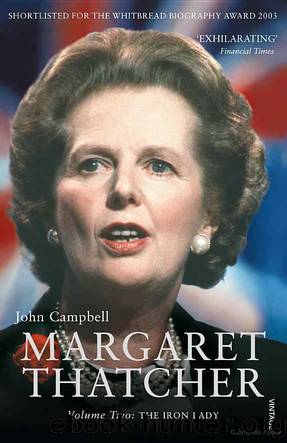Margaret Thatcher Volume Two: The Iron Lady by John Campbell

Author:John Campbell
Language: eng
Format: mobi
Tags: Biography
ISBN: 9781446420089
Publisher: Vintage
Published: 2011-04-29T23:00:00+00:00
The Anglo-Irish Agreement
Several factors pushed her in this direction. First was the return of Garret Fitzgerald as Taoiseach in December 1982, soon followed by her own re-election in June 1983. Just as she thought the chance for progress in the Middle East should be seized while Shimon Peres was Prime Minister of Israel, so she believed it might be possible to achieve something with the moderate and constructive Fitzgerald which she could not do with the posturing Haughey. Fitzgerald recognised that Ireland could only be united by consent. He had spoken in 1981 of a ‘republican crusade’ to reform those aspects of the Irish constitution which antagonised Protestants, and specifically of scrapping clauses 2 and 3 which laid territorial claim to the Six Counties.30 But instead of grand gestures, he was anxious to proceed incrementally by rebuilding the confidence of northern nationalists in the SDLP and diminishing support for Sinn Fein and the IRA. Though she found him at times tiresomely verbose and academic, Mrs Thatcher ‘trusted and liked and perhaps even admired Garret Fitzgerald’, in the words of one of her junior ministers in the Northern Ireland Office. ‘She thought he was straight and that he wasn’t trying to pull a fast one on her.’31 At least – unlike Haughey – he expressed a proper outrage at the bombs in London. Geoffrey Howe has spoken of ‘an extraordinary chemistry’ between the two leaders which he compares to her relationship with Mikhail Gorbachev.32
Second, despite her Unionist sympathies Mrs Thatcher did actually – as with the Palestinians – come to a partial appreciation of the nationalist case. Fitzgerald wrote in his memoirs that she always resisted his use of the term ‘alienation’ to describe the northern Catholics’ sense of exclusion from the institutions of Northern Ireland, believing it to be a Marxist term. But she acknowledged the reality. When she was persuaded that the IRA and their Sinn Fein apologists were not Irish infiltrators but predominantly British citizens, an indigenous northern movement poorly supported in the Republic, and that the legitimate nationalist party, the SDLP, won a lot of impeccably democratic votes – 18 per cent in 1983, compared with 13 per cent for Sinn Fein – she became convinced that the law-abiding Catholic community had somehow to be reconciled to the British state. The journalist Edward Pearce recalls a dinner conversation in 1985 at which Charles Moore, then editor of the Spectator, asked her ‘What about the Protestants?’ ‘She leaned into the table and in her best taut, intense … way [replied] “Yes, Charles, and what about the Catholics?” … All the fierceness which she would misuse in hating the Germans and despising the unemployed was turned towards getting a decent equity for the minority. It was wonderful.’33 She could never accept the idea of dual allegiance – she resented the anomalous right of the Irish to vote in British elections, and thought like Enoch Powell that they should be treated logically as foreign – but she came to see that the legacy of history gave the Republic an interest in the equitable government of the north.
Download
This site does not store any files on its server. We only index and link to content provided by other sites. Please contact the content providers to delete copyright contents if any and email us, we'll remove relevant links or contents immediately.
Blood and Oil by Bradley Hope(1531)
Wandering in Strange Lands by Morgan Jerkins(1374)
Ambition and Desire: The Dangerous Life of Josephine Bonaparte by Kate Williams(1347)
Daniel Holmes: A Memoir From Malta's Prison: From a cage, on a rock, in a puddle... by Daniel Holmes(1295)
It Was All a Lie by Stuart Stevens;(1265)
Twelve Caesars by Mary Beard(1258)
The First Conspiracy by Brad Meltzer & Josh Mensch(1140)
What Really Happened: The Death of Hitler by Robert J. Hutchinson(1131)
London in the Twentieth Century by Jerry White(1114)
Time of the Magicians by Wolfram Eilenberger(1091)
The Japanese by Christopher Harding(1086)
Twilight of the Gods by Ian W. Toll(1085)
Cleopatra by Alberto Angela(1063)
A Woman by Sibilla Aleramo(1054)
Lenin: A Biography by Robert Service(1046)
The Devil You Know by Charles M. Blow(987)
Reading for Life by Philip Davis(974)
1965--The Most Revolutionary Year in Music by Andrew Grant Jackson(925)
The Life of William Faulkner by Carl Rollyson(925)
